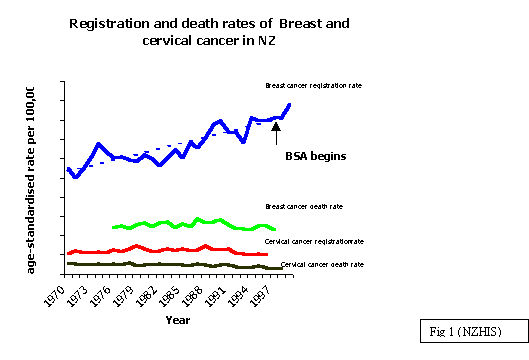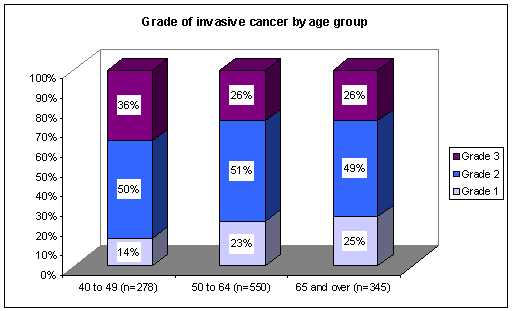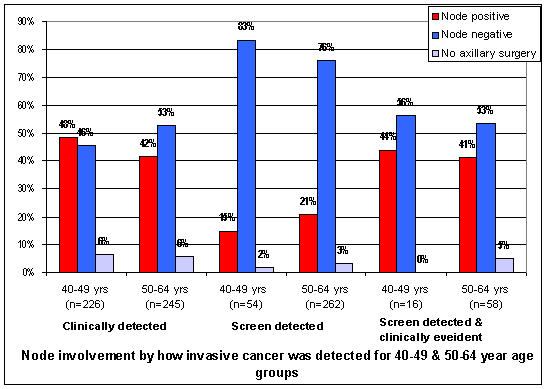WHY SCREENING MAMMOGRAMS SHOULD BE OFFERED TO WOMEN IN THE 40s
- submission to the Select Health Committee, 25th February 2004
Dr Jackie Blue, Breast Physician, St Marks Woman's Health, Auckland
Dr Benji Benjamin Dr Barbara Hochstein
Clinical Director Breast Radiologist
Radiation Oncology Lakes Radiology and Lakeland Health
Auckland Hospital Rotorua
Dr David Benson-Cooper Mr Wayne Jones
Breast Radiologist Clinical Director - General Surgery Auckland Hospital
Mercy Radiology Head of the Auckland Breast Surgery Unit
Auckland General Breast and Endocrine Surgeon
Auckland
Dr Sonja Freese
Breast Physician Dr Margie Weston
Breast Associates Breast Radiologist
Auckland Auckland
Dr Sue McKeage
Breast Surgeon
Auckland
Mr Stan Govender
Breast Surgeon
Auckland
Dr Marli Gregory
Breast Physician
Auckland
Mr John Harman
Breast Surgeon
Auckland
Dr Heather McIntyre
Breast Physician
Auckland
Dr Karen Parker
Breast Physician
Auckland
Dr Ken Judd
Breast Radiologist
Auckland
Breast cancer in New Zealand
Breast cancer has been steadily increasing in New Zealand over the last 30 years and as a
comparison presents a far greater health issue than cervical cancer. The breast cancer death
rate has reduced 19% over the last decade. This reduction has been mirrored internationally
and is believed to be due to the use of adjuvant treatment. BreastScreen Aotearoa (BSA) began
in late 1998 and as a result of increased early detection, the 1999 registration rate
increased sharply (Fig 1). There was an 8% increase in the registrations from 1998 to 1999,
which is directly attributable to increased diagnosis in the BSA target age group 50-64 group (Fig 4).
Cervical cancer does not have the same impact as breast cancer; almost 10 times more women die
of breast cancer each year than cervical cancer. Breast cancer becomes more common as women age
and as NZ has an ageing 'baby boomer" population, in the next decade we will see large numbers
of women diagnosed with breast cancer.
New Zealand's breast cancer incidence is similar to Australia. However, Prof David Skegg when
he compared the 2 countries concluded that NZ women have a 28% greater chance of dying of
breast cancer compared with Australian women (1). BreastScreen Australia began in 1991.
Screening mammography has been offered to Australian women in the 40-49 yr age group since the
outset and although this group is not actively recruited, 20% of the eligible group has mammography
through the Australian programme. It is impossible to tease out as to why women with breast cancer
in New Zealand have a greater chance of dying of their disease compared with their Australian counterpart.
Improved survival for those women who have screening mammography in the 40s is just as valid a reason as
is more effective and timely treatment services.

Breast cancer - actual numbers per decade
Of the over 2000 women diagnosed with breast cancer annually in New Zealand, 20% are in the 40s.
In comparison, women in the 50s accounts for 25%, women in the 60s - 21%, women in the
70s -16% and women 80 and over accounts for 13%. The proportion of women who are diagnosed
in the 40s is not an insignificant number (Fig 2).
Breast cancer - registration rates over the last 5 years
Breast cancer is more common as women age and this is reflected in breast cancer registration
rates over the last 5 years of available data (1997,1998,1999,2000,2002). However, it is
important to note that this data is inevitably skewed; the introduction of BreastScreen
Aotearoa for women 50-64 years in late 1998 resulted in a marked increase in the registration
rate, which is directly attributable to increased diagnosis in the 50-64 group. (Fig1,3,4).
The skewing of the data for women 50-64 year with the introduction of BSA serves to understate
registrations in 40-49 age group.
Breast cancer death- actual number and rates
The actual numbers and death rate from female breast cancer reflects the increasing
registration rate; it is an established fact that breast cancer is more common as women age.
In 1999 for women in the 40s and 50s, breast cancer by far is the commonest cause of
death in these respective age groups (NZHIS). For the 30% of women who die from this
disease, death from breast cancer may be some years after diagnosis and therefore death
rates of women in 40-49 age group more accurately reflects those women diagnosed in the
30s. Similarly the death rate for women in the 50s may more accurately reflect those
women who were diagnosed in the 40s. The sharp increased breast cancer death rate in
women 85 years and over may reflect the difficulty in establishing an accurate cause of
death in this age group (Fig 5,6).
Auckland Breast Cancer Study Group (data reproduced with permission from the ABCSG)
Since June 2000 the Auckland Breast Cancer Study Group (ABCSG) have reviewed data from all
breast cancer cases occurring in the Auckland region, Currently 1800 consented patients are
recorded on ABC register. The ABCSG data confirm that women in the 40-49 yr age group have
a 10% higher rate of the most aggressive tumours (Grade 3), than women over 50 years. This
data is consistent evidence that cancers in premenopausal women are faster growing and more
aggressive than in post-menopausal women. It is for this reason that women 40-49 require
annual mammography compared with 2-yearly mammography for women over 50 years. Over
75% of women in the 40-49 years age group presented with a palpable lump, compared to
43% of women eligible for screening. This data also demonstrates that clinically detected or
palpable cancers have a higher rate of lymph node involvement, which is 6% higher in the 40-
49 age group compared to clinically detected tumours in women eligible for screening. Lymph
node involvement is a negative prognostic indicator.
Flawed arguments levelled against screening mammography in the 40s
The standard arguments that have continued to be used against screening women in the
40s are flawed and no longer can be justified.
1. Women in the 40s have dense mammograms. Therefore cancers will be missed and there
will be more false positives.
There is no magical change in mammographic denseness at age 50 years. Over
time, breast tissue gradually becomes more fat replaced. At age 30 years approx
90% of women have mammographically dense tissue and this changes by 1-2% per year
such that at age 65-70 years, 60% of women will have fat replaced breast tissue.
As such, there is no significant difference with regards to mammographic denseness
when women 40-49 and 50-59 are compared. Breast cancer is more common as women age
and when this is taken into consideration, recent Australian data from
BreastScreen Victoria confirms that cancer detection rates are comparative and
recall rates from screening mammography are similar. The recall rate for first time
attenders is within the recognised international and BSA target for both groups
(2, Fig 9,10). The recall rates for subsequent attenders for both women in the 40s
and 50-69 yrs is slightly outside the international and BSA target. It is a credit to
BSA that lead providers consistently meet stringent BSA targets for women 50-64 yrs
and because of the quality of providers in NZ would be able to meet targets for women
40-49 yrs. Of note, Victoria (Australia) has a similar population to NZ.
2. Mammograms in the 40s will make women anxious - refer to submission Danute
Ziginskas, Clinical Psychologist.
3. The risks and harms of mammography in the 40s outweighs any benefit.
Other risks of screening mammography include cancers that are detected but whose
outlook is unaltered by an earlier diagnosis and over-treatment of abnormalities such as
ductal carcinoma in situ (DCIS). There is no simple way to compare the risks versus the
benefits; they will be perceived differently by different women.
4. The benefit of screening appears delayed in younger women. The delayed benefit is
because a woman has turned 50 and screening should therefore start at 50 years.
It is not clear why the benefit is delayed in younger women or indeed what the
significance of this is. Possible factors that influenced the apparent delayed in benefit
of screening are that younger women having faster growing cancers. Importantly all the
controlled trials had variable screening intervals (12-33 months) and we now know that
women in the 40s need annual mammography. Experts believe that if the correct annual
screening interval had been applied to this age group, the time it would take to see the
benefit of screening would be similar to the 50 and over age group (4-5 years after screening
begins)(3). Importantly the window of opportunity to prevent death from breast cancer may
occur early in its growth even though it may not be fatal for many years.
5. The screening trials conducted in the latter half of last century do not show a
benefit in screening women in the 40s
Over the past thirty years there have been eight controlled trials looking at
whether regular screening mammography reduces the number of women dying from
breast cancer. The eight controlled trials varied in recruitment of participants,
age groups screened, the time between mammograms or screening interval, mammography
protocols, control groups, and size. Only one trial specifically looked at the
40-49 year age group (Canadian CNBSS-1). The Canadian trial is now considered by
experts to be flawed due to selection bias of the screened group. Over time there
has been intense review and re-analysis looking at different combinations of the
controlled trials. In 2002, the United States Preventative Services Task Force
(USPSTF) analysed all the trial data to date and when the Canadian trial was excluded,
determined that there was a 20% reduction in breast cancer death in women who have
screening mammograms in the 40s (4). This is worst-case scenario. Tabar has emphasized
that the meta-analyses of women in the 40s underestimates the benefit of screening (5).
In contrast there are individual trials such as the Gothenberg trial, which showed
a 42% reduction in breast cancer mortality for women 40-49yrs (4).
However, it is believed that if a theoretical annual screening interval to the
40-49 yr group, the reduction in breast cancer death is thought to be at least
as good as and may even be better than the over 50 year result of 30% reduction
in breast cancer death. For instance, the Gothenberg trial (6), which screened women
40-49 yrs every 18 months, showed a 42% reduction in breast cancer death. Not all
women invited for a screen had a mammogram but these women are included in the
calculations. It has been theoretically calculated that if 100% of women had a
mammogram the reduction in breast cancer deaths would be 55% and if the women had
an annual mammogram the reduction in mortality would be as high as 73%.
Other considerations for screening women in the 40s
An analogy to breast cancer development in women in the 40s is like a snowball rolling
down a mountain. Just as a snowball gets bigger and gains speed, breast cancers in the
40s get more aggressive and bigger (potential for dedifferentiation or worsening of
malignancy grade during tumour growth). Tabar estimates that 8 breast cancers out of 10
(81%) have the potential of dedifferentiation in the 40-54 age group, while this figure
is one out of two (50%) in women aged 55 and older (5).
Importantly when a young woman in her 40s is saved from dying from breast cancer there
is more life-years saved compared to an older woman. In New Zealand since 1992, the
numbers of live births for women aged between 35-45 years has doubled from 10% of the
total live births to almost 20% (7). The social fallout to the family is huge when a
young woman dies.
The actual benefit from breast cancer screening is primarily important to the individual
woman who is interested in reducing her risk of dying from breast cancer. Women in the
40s must have the absolute right to make an informed decision and be offered choice.
Countries such as Australia who are currently offering half pie screening in the 40s
but not actively recruiting this age group need to get off the fence. New Zealand has
an opportunity to be a leader and not a follower in women's health.
REFERENCES:
(1) Skegg et al, NZ Med J 2002; 115:205-8
(2) A decade of achievement BreastScreen Victoria 1992-2002 and BreastScreen Victoria 2001, Annual Statistical Report
(3) Kopans, Breast Imaging 2nd Edition, Lippincott Williams and Wilkins
(4) Humphrey et al Summary of the Evidence - Breast Cancer Screening http://www.ahrq.gov/clinic
(5) Tabar statement to the NZPA 2002
(6) Bjurstam et al, Journal of the National Cancer Institute. (22): 53-5, 1997.
(7) Statistics New Zealand, www.stats.govt.nz




